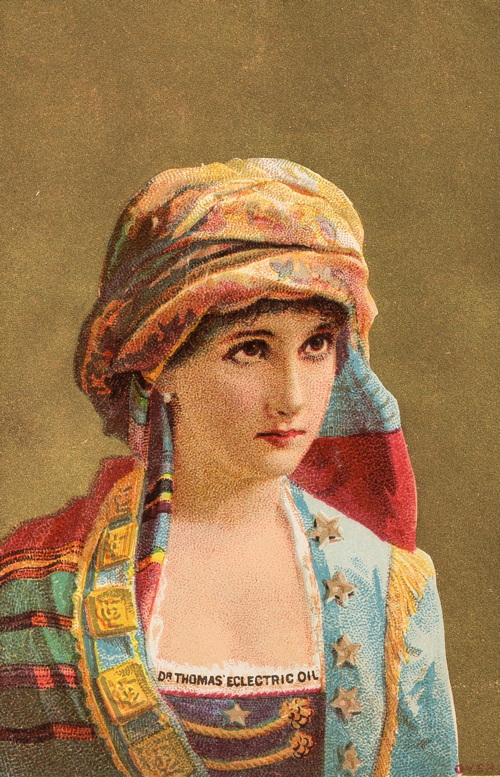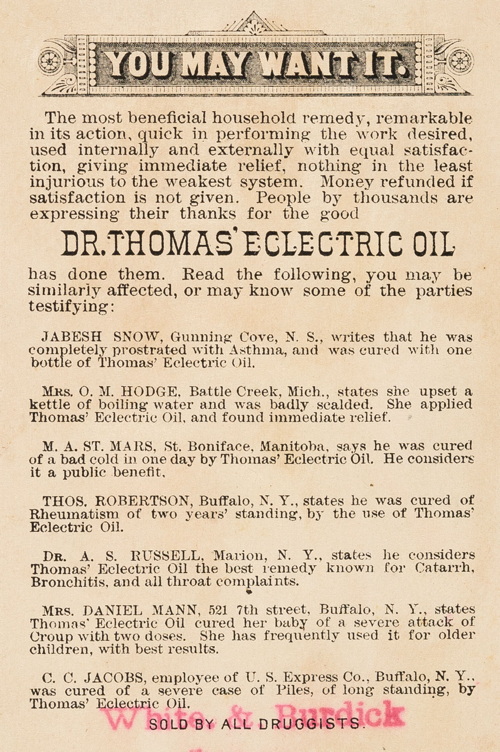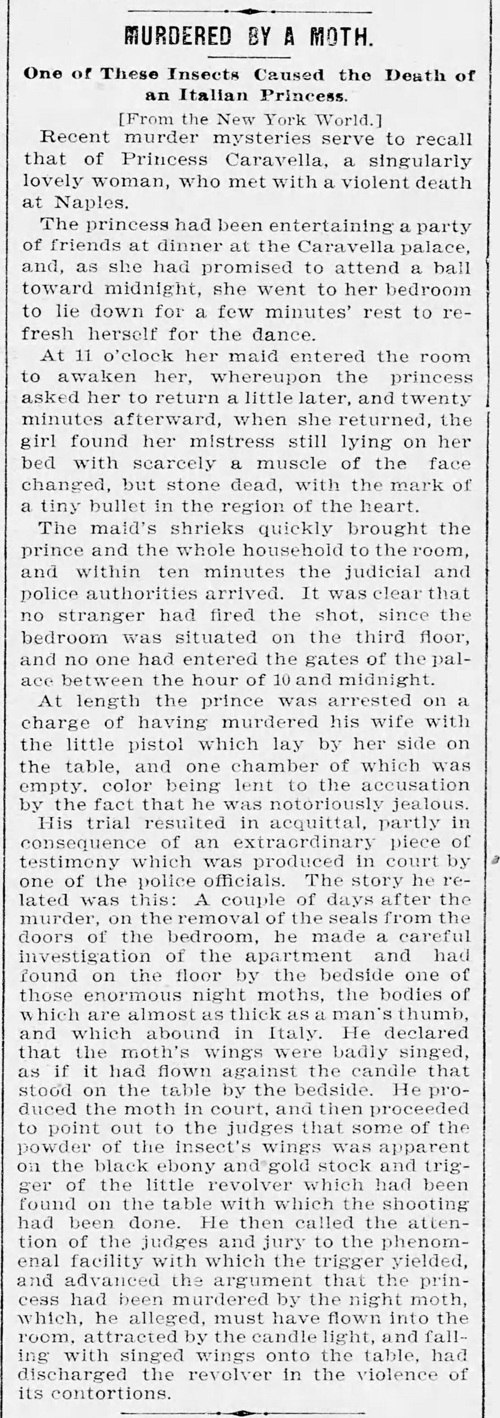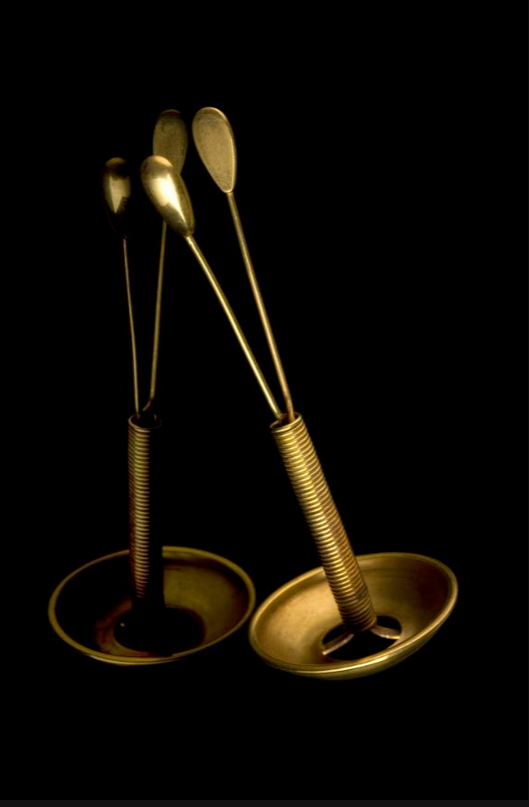Nineteenth Century
The Cellular Cosmogony
Here's your chance to learn the truth: that we are all living inside the Earth, rather than on top of its surface.The Wikipedia page for Koresh, aka Cyrus Teed.


Posted By: Paul - Thu Jul 18, 2024 -
Comments (4)
Category: Eccentrics, Frauds, Cons and Scams, New Age, Spaceflight, Astronautics, and Astronomy, Nineteenth Century
The Smoking Baby of Trenton
Winfield Doran gained famed as the "smoking baby of Trenton." He started smoking a pipe when he was seven months old. Because his parents were worried about the health effects of this, they eventually persuaded him to smoke cigars instead. But he refused to smoke cigarettes.He died of diptheria when he was four years old.


Canton Independent Sentinel - Aug 14, 1890

Quincy Daily Ledger - Nov 11, 1890
Posted By: Alex - Thu Jul 11, 2024 -
Comments (0)
Category: Babies and Toddlers, Children, Smoking and Tobacco, Nineteenth Century
An inglorious Columbus : or, Evidence that Hwui Shn and a party of Buddhist monks from Afghanistan discovered America in the fifth century, A.D
Why waste your red paint and enmity on statues of Columbus, when it was really the Chinese who discovered America?Read it here.



Posted By: Paul - Sun Jun 30, 2024 -
Comments (4)
Category: Explorers, Frontiersmen, and Conquerors, Fables, Myths, Urban Legends, Rumors, Water-Cooler Lore, Asia, North America, Nineteenth Century
Unlikely Reasons for Murder No. 18


Posted By: Paul - Sat Jun 15, 2024 -
Comments (2)
Category: Death, Europe, United Kingdom, Nineteenth Century
Tooth Cap
The Southwark Heritage art museum has a nineteenth-century tooth cap in its collection. It offers this description:
If the cap looks like something you'd like to own, the website toothantique.com claims to be selling them. Newly made tooth caps, not nineteenth-century originals. They're asking only $100. For that price they say you get a cap "Decorated With 40 Real Human Teeth, Drilled And Attached With Twine."
Are they really selling these caps? I'm somewhat doubtful. The picture of their product is the same picture that's on the Southwark Heritage site. But I'm not curious enough to spend $100 to find out what would arrive in the mail.
Posted By: Alex - Fri May 31, 2024 -
Comments (1)
Category: Headgear, Nineteenth Century, Teeth
Presidential Songs and Slogans
In this election year, we could do with some innovative songs and slogans--but I doubt if we'll get any that compare to these historical ones.Taken from THE BOOK OF POLITICAL LISTS.






Posted By: Paul - Mon May 20, 2024 -
Comments (5)
Category: Music, Politics, Proverbs, Maxims, Sayings, Folk Wisdom and Quotations, Nineteenth Century, Twentieth Century
Helmbold’s Extract of Buchu
Read all about the herb buchu and its medicinal merchandising here.One of the most (in)famous protagonists was Henry T. Helmbold (1826–1892), who started his patent medicine business in 1846 as a retail druggist with “Helmbold’s Extract Buchu—cures diabetes, gravel, brick-dust deposits, irritations of the bladder and diseases arising from exposure or imprudence, etc.” and other medicines. He opened his first store in Philadelphia in 1850, the largest and best-known in New York in 1862. By 1865 Helmbold’s buchu was the bestselling patent medicine on the US market. For this, he spent enormous amounts of money on advertising, mostly in newspapers: ∼US$ 500,000 (about 10 million US$ today) each for the years 1869–71. For the distribution of his products, Helmbold had his own 4c postage stamp (Figure 4) (The Historian, 1912; Young, 1961).

The Hottentot ad is for Helmsbold's product. It has three more pages, viewable here.

Posted By: Paul - Fri May 10, 2024 -
Comments (2)
Category: Patent Medicines, Nostrums and Snake Oil, Africa, Nineteenth Century
Eclectric Oil
Dr. Thomas' Eclectric Oil was widely sold as a cure-all in the second half of the nineteenth century and well into the twentieth. This was even though, as Wikipedia notes, it "mostly contained common ingredients such as turpentine and camphor oil."Some of the things it supposedly cured included rheumatism, lame backs, sore throats, coughs and colds, throat and lung disease, and asthma. It could even cure "chicken flesh wounds" (see ad below).
Wikipedia notes that the name Eclectric Oil was "likely a portmanteau of the words 'eclectic' and 'electric', alluding to the then-popular belief that electricity had curative powers." Of course, the oil was not electric in any way.


image source: wellcome collection

Canadian Poultry Review - Apr 1926
Posted By: Alex - Sun Apr 07, 2024 -
Comments (0)
Category: Patent Medicines, Nostrums and Snake Oil, Nineteenth Century
The Princess Who Was Murdered by a Moth
The story goes that Princess Caravella of Italy was found dead in her bed, shot through the heart. Her husband was accused of her murder, but during the trial a police investigator convinced the jury that the Princess had actually been killed by a moth that singed its wings on a candle in her room, then fell onto a pistol lying on her bedside table, thereby causing the weapon to fire, shooting her through the heart.I doubt any part of this story is true. After all, I can't find any historical references to a "Princess Caravella" other than the ones about her strange death. But the story was printed repeatedly in newspapers during the first half of the twentieth, always presented as an odd but true tale.
The earliest account of the story I can find dates to 1895, where it was credited to the New York World. I assume a reporter for the New York World made it up.

Chicago Chronicle - Dec 29, 1895
Here's a slightly shorter version of the story from 1937.

Tunkhannock New Age - Feb 18, 1937
I can't find the story in papers after the 1940s, but it did continue to pop up in books about odd trivia and weird deaths. For instance, below is a version that appeared in the 1985 weird-news book Own Goals by Graham Jones. Note that Jones identified Princess Caravella only as an "Italian wife," making the story seem more contemporary.

Posted By: Alex - Thu Mar 14, 2024 -
Comments (2)
Category: Death, Insects and Spiders, Nineteenth Century
Mystery Gadget 109
What's it for?The answer is here.
Or after the jump.

More in extended >>
Posted By: Paul - Thu Mar 07, 2024 -
Comments (3)
Category: Technology, Nineteenth Century

| Who We Are |
|---|
| Alex Boese Alex is the creator and curator of the Museum of Hoaxes. He's also the author of various weird, non-fiction, science-themed books such as Elephants on Acid and Psychedelic Apes. Paul Di Filippo Paul has been paid to put weird ideas into fictional form for over thirty years, in his career as a noted science fiction writer. He has recently begun blogging on many curious topics with three fellow writers at The Inferior 4+1. Contact Us |




